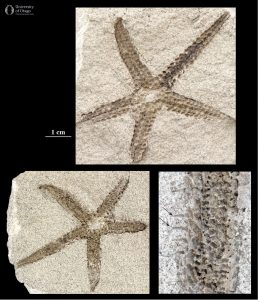31 A Jurassic asteroid from the Catlins
The reference collection in the Geology Museum contains a nearly complete mould of a 170 million year old fossil asteroid, the formal scientific name for starfish, from the Catlins, South Otago. Entire specimens of starfish are uncommon as fossils as they usually disintegrate after death, and only a dozen or so specimens are recorded from Aotearoa to date.

The reference collection in the Geology Museum contains a nearly complete mould of a 170 million year old fossil starfish from the Catlins, Southland. Entire specimens of starfish are uncommon as fossils as they usually disintegrate after death, and only a dozen or so specimens are recorded from Aotearoa to date.
The specimen consists of the two halves (part and counterpart) of an asteroid that measures about 10 cm in maximum diameter, with arms that are 4-5 cm long. The ossicle skeleton must have been preserved as the rock became cemented, but the skeleton has later dissolved, leaving the empty space in the exact shape of the animal (a mould). The imprint of tiny spines are also preserved.
This specimen has an interesting provenance. It was collected as a concretion from an old quarry in the Catlins and left outside in a pile of rocks over the winter.
Craig writes: I was given the unopened concretion by a friend of our family as a gift. They wondered if anything was inside and knew I was into fossils. I split the concretion, but there was nothing visible inside. I chucked it in the garden rock pile and was shocked to see the starfish after a few winters of natural freeze thaw split it along the plane of the starfish!
Just two other starfish of Jurassic age have been reported from Aotearoa. The first specimen comes from South Auckland, in rocks of similar age to those in the Catlins. This tiny specimen, just 11 mm in diameter, was discovered in 1952 and described two years later by HB Fell as Odontaster priscus. The second, slightly larger specimen, was collected from a similar area near Port Waikato, and again described as a new species and placed in a genus recorded previously only from the Middle Jurassic of France.
Thus, this interesting specimen from the opposite end of New Zealand is an important addition to the history of echinoderms in Zealandia.
All starfish today are predators, opportunistic feeders (ie whatever they find) on benthic invertebrates, mostly molluscs.
– Written by Daphne E Lee, Craig Woodward and Jeffrey Robinson
| Specimen number: OU 19353 | Age: Approximately 170 million years old (middle Jurassic, Temaikan Stage) |
| Locality: Disused quarry, Warnock Road, Catlins, South Otago | Rock Formation: Purakauiti Formation |
| Donated by: Craig Woodward | |
| Citation: Yet to be described |

